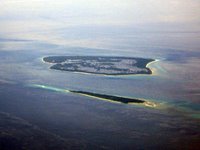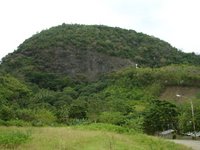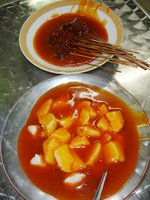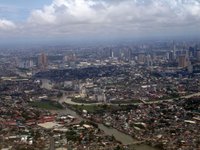 So I was up early to make sure I made the 7 a.m. call time. There was still no sign of the group at 7:15 a.m. so that got me worried. Until finally someone had approached me asking if I was the one who was going to tag along. It turned out, the group had two designated meeting places. And the bigger group which was at the pier was gone before the organizer had arrived. To make things worse, there were just three of us at Lantaka Hotel, myself, the organizer and a student.
So I was up early to make sure I made the 7 a.m. call time. There was still no sign of the group at 7:15 a.m. so that got me worried. Until finally someone had approached me asking if I was the one who was going to tag along. It turned out, the group had two designated meeting places. And the bigger group which was at the pier was gone before the organizer had arrived. To make things worse, there were just three of us at Lantaka Hotel, myself, the organizer and a student. After waiting for sometime, we decided to check again at the pier. We would later find out when we got to the island that the group which met at the pier, after seeing the rough waves which were a result of the tail end of "Inday," had backed out! Anyway, after some haggling with the boat owner, we were able to bring down the cost thanks to our appeal to pity.
After waiting for sometime, we decided to check again at the pier. We would later find out when we got to the island that the group which met at the pier, after seeing the rough waves which were a result of the tail end of "Inday," had backed out! Anyway, after some haggling with the boat owner, we were able to bring down the cost thanks to our appeal to pity.So the three of us made the trip to Santa Cruz despite the rough seas. And I was tense for the most part as our boat made the slow trip to the island, rocked by strong waves. I was actually praying for sunshine. We got there in one piece. And for some twist of fate, the sun did come out a few minutes after we arrived on Great Santa Cruz Island.
 The two islands which are a few meters away from each other, and the waters that surround it form the Great and Little Santa Cruz Island Protected Landscapes and Seascapes. Both islands often play host to environmental activities with students from local universities such as Ateneo de Zamboanga organizing tree-planting activities and coastal clean-ups. There are just about forty families which live on the island, all from the Samal tribe which was allowed to stay in the protected area.
The two islands which are a few meters away from each other, and the waters that surround it form the Great and Little Santa Cruz Island Protected Landscapes and Seascapes. Both islands often play host to environmental activities with students from local universities such as Ateneo de Zamboanga organizing tree-planting activities and coastal clean-ups. There are just about forty families which live on the island, all from the Samal tribe which was allowed to stay in the protected area.What makes the sand on the island unique is its distinct pink color which is a result of tiny pink coral fragments mixed with the white sand. For a close up of the sand, click here. And just like in Malamawi White Beach, I had the beach all to myself! We learned from the locals there that even before Puerto Galera and Boracay, Santa Cruz was a popular destination among tourists. But after the spate of abductions and kidnappings many years back, its popularity waned.
 Anyway, after a brief dip in the blue water, I decided to walk around the island. It would take two hours to walk around from end to end. So I just hiked a few meters to check out the other side. As you can see from an aerial photo which I took from the plane, the center of the island was mostly mangrove swamps and a lagoon.
Anyway, after a brief dip in the blue water, I decided to walk around the island. It would take two hours to walk around from end to end. So I just hiked a few meters to check out the other side. As you can see from an aerial photo which I took from the plane, the center of the island was mostly mangrove swamps and a lagoon.We went back to downtown Zamboanga at about 12 noon and this time, the water was calmer. But I had a worse headache than the day before. Again, I decided to eat at Tini's where I ordered murtabak daging (beef prata) and roti kosong (flour pancake). Then I walked back to the pension house to freshen up and take a quick nap. I made sure not to sleep too long since I wanted to visit as much as I could during my last 24 hours in Zamboanga City.
 Next on my itinerary was a trip to Mt. Pulong Bato in Barangay Abong Abong from where visitors are rewarded with a breathtaking view of Zamboanga City and the outlying islands. From downtown, I took a jeep to Abong Abong via Pasonanca which was just PHP10. Make sure you mention to the driver that you want to visit the stations of the cross so that he could drop you off at the foot of the mountain. I was dropped off at a place called canyon or Freedom Park which had some military relics, large guns in particular hence the moniker canyon, and a tomb for an unknown soldier.
Next on my itinerary was a trip to Mt. Pulong Bato in Barangay Abong Abong from where visitors are rewarded with a breathtaking view of Zamboanga City and the outlying islands. From downtown, I took a jeep to Abong Abong via Pasonanca which was just PHP10. Make sure you mention to the driver that you want to visit the stations of the cross so that he could drop you off at the foot of the mountain. I was dropped off at a place called canyon or Freedom Park which had some military relics, large guns in particular hence the moniker canyon, and a tomb for an unknown soldier. I thus ended up walking an extra 1.5 kilometers to the foot of the mountain, not including the 750 meter steep climb to the vantage point. On the way up were bas relief murals of the fourteen stations of the cross. That was really exhausting! But the view from on top was worth the climb. Since the road is well paved, you can drive a vehicle up as well.
I thus ended up walking an extra 1.5 kilometers to the foot of the mountain, not including the 750 meter steep climb to the vantage point. On the way up were bas relief murals of the fourteen stations of the cross. That was really exhausting! But the view from on top was worth the climb. Since the road is well paved, you can drive a vehicle up as well. It was about 3:30 p.m. and I had to rush down and back to downtown since I had one more destination on my itinerary, the oldest mosque in Zamboanga in Barangay Taluksangay. People had warned me that it was going to be far but that did not hinder me. So as soon as I got back to downtown, I immediately boarded a jeep to the Muslim community of Taluksangay near the Mercedes District. It was about 17 kilometers away and the fare was PHP20.
It was about 3:30 p.m. and I had to rush down and back to downtown since I had one more destination on my itinerary, the oldest mosque in Zamboanga in Barangay Taluksangay. People had warned me that it was going to be far but that did not hinder me. So as soon as I got back to downtown, I immediately boarded a jeep to the Muslim community of Taluksangay near the Mercedes District. It was about 17 kilometers away and the fare was PHP20.I arrived there at 5 p.m. just before the sun went down. I was happy to see a marker of the National Historical Institute which emphasized the significance of the site to our nation's history.
 As I mentioned earlier, this was the first mosque in the Zamboanga Peninsula. Built by Hadji Abdullah Maas Nuno in 1885, it was the first center of Islam which was recognized by the international Islamic community.
As I mentioned earlier, this was the first mosque in the Zamboanga Peninsula. Built by Hadji Abdullah Maas Nuno in 1885, it was the first center of Islam which was recognized by the international Islamic community.Anyway, going back to downtown Zamboanga City was going to be a problem since the jeepney driver had mentioned me that there were no more trips back. So from Taluksangay, I took a pedicab to the next barangay which was Talabaan where motorcycles-for-hire were waiting to take me back to the highway. The trip was PHP30 and I agreed since I would be able to stopover at the Gabaldon buildings in the Mercedes Central School. I was surprised to see many of the buildings intact. Aside from the main building, the original home economics and industrial arts buildings were still standing.
From the highway, I took a jeep back to downtown. The good thing about the public transport system in Zamboanga City is that all jeepneys travel to the downtown area so you can easily find you way around. I got off at St. Joseph's Church to hear Mass. The church was air-conditioned which was a welcome feeling after a humid and tiring day.
 After Mass, my plan was to check out those satti outlets again. It was just 7 p.m. and I was surprised to see all of them closed! So I asked a tricycle driver to take me to the nearest sattihan. The driver mentioned to me that those were the only ones he knew. And that the reason they closed early was because they were open as early as 4 a.m. So that's why! It turns out satti was a breakfast dish in Zamboanga.
After Mass, my plan was to check out those satti outlets again. It was just 7 p.m. and I was surprised to see all of them closed! So I asked a tricycle driver to take me to the nearest sattihan. The driver mentioned to me that those were the only ones he knew. And that the reason they closed early was because they were open as early as 4 a.m. So that's why! It turns out satti was a breakfast dish in Zamboanga.Anyway, I went back to Tini's for dinner since this was the last chance I could eat roti in a long time. And I made sure I went to bed early since my plan was to savor the elusive satti before I left on the 9:55 a.m. flight. I was up at 6 a.m. and finally, I was able to treat myself to satti! As I mentioned in a previous post, these were three small pieces of roasted beef on a barbeque stick dipped in a bowl of sweet and spicy sauce served with rice floating in another plate of the same sauce. Each was PHP3.50 and the rice was something like PHP8 per serving (if you remember the rice I had in Larsian which I mentioned in my Cebu entry, it was the same one).
I then went back to the pension house to take a quick nap. After checking out, I took a tricycle to the airport for PHP30. I was quite early for the flight but it was better to be there early than to be left behind. Good thing there was a massage service there so I got myself relaxed before boarding.
 One thing I liked about the experience at the airport was that everyone on the runway, from the ground crew to the security guards waved at the plane as it left the tarmac. It was a very heartwarming experience for passengers looking out the windows.
One thing I liked about the experience at the airport was that everyone on the runway, from the ground crew to the security guards waved at the plane as it left the tarmac. It was a very heartwarming experience for passengers looking out the windows.I took a lot of photos on the plane as well. Here are two of them. The first is the Ortigas area with the Pasig River and the old Rizal Provincial Capitol in the green open space along the river close to the center of the photo. The bridge you see is the C5 Bridge.
 The second photo is Makati with the Fort Bonifacio Global City and American Cemetery in the foreground. I guess that's it for now. Until the next trip.
The second photo is Makati with the Fort Bonifacio Global City and American Cemetery in the foreground. I guess that's it for now. Until the next trip.

This comment has been removed by the author.
ReplyDeleteThere is a samal cemetery along the beach of the Great Sta. Cruz island. Just walk from where the boat docks and if you are observant enough you will see the grave markers.
ReplyDeletedid you know how to speak chabacano? because most of the people there talk chabacano.
ReplyDeleteI apologize for hijacking this post's comment function for a bit. I am currently undertaking my undergrad thesis on spatial representation and discourse, a study my group and I have anchored on Zamboanga City and online information effectively surrounding it. Would you be willing to play respondent to one or two interview email exchanges? We would greatly appreciate it.
ReplyDeleteThanks for the beautiful blog about Zamboanga city..i'am from zamboanga city and i have lived here ever since i was born... Have you been to 11 islands?? it is also located in zamboanga city...the white sand there is much powdery than boracay and you can see the live corals...the palce is beautiful..
ReplyDeleteThanks for the lead. I'll keep that in mind when I visit Zamboanga City again.
ReplyDeletehow much is the fare going to sta. cruz island back and forth.
ReplyDeleteis it safe to visit zamboanga, sulu and tawitawi alone? can you give tips on how to have a safe travel..
ReplyDelete